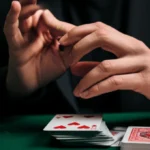Support our educational content for free when you purchase through links on our site. Learn more
Unlock the Secrets of the Mind: 9 Fascinating Ways to “Think of a Number Between 1 and 10” 🎩
Have you ever been in a room full of friends, and someone casually says, “Think of a number between 1 and 10”? Suddenly, the air is thick with suspense, and everyone’s eyes are glued to the person who claims they can read minds. It’s a classic party trick that seems simple but is steeped in psychological intrigue and mathematical wizardry!
In this article, we’ll dive deep into the world of number games, exploring 9 captivating variations of the “Think of a number between 1 and 10” trick that will not only entertain but also educate. Did you know that people are more likely to choose certain numbers over others? 🤔 We’ll reveal the psychological reasons behind these choices and how you can use them to your advantage. Plus, we’ll share tips on how to engage your audience and make your performance unforgettable!
Key Takeaways
- Master the Basics: Learn the simple steps to perform the classic number trick effectively.
- Psychological Insights: Understand why certain numbers are more popular choices and how to exploit this in your tricks.
- Variations Galore: Explore 9 exciting adaptations of the number game that can keep your audience guessing.
- Educational Value: Discover how these tricks can be used as fun teaching tools for math concepts.
- Engagement Tips: Get practical advice on how to captivate your audience and enhance your performance.
Ready to amaze your friends and family? Check out our recommended products for magic tricks and educational resources! Shop Magic Tricks on Amazon | Explore Educational Games
Table of Contents
- Quick Tips and Facts
- The Magic of Number Selection: A Brief History
- How to Play “Think of a Number Between 1 and 10” Game
- The Psychology Behind Number Choices
- Fun Variations of the Number Game
- Free Number Generator Services You Can Use
- Features of This Random Picker: Why It’s a Game Changer
- Tips for Engaging Your Audience in Number Games
- Using Number Games for Educational Purposes
- Conclusion
- Recommended Links
- FAQ
- Reference Links
1. Quick Tips and Facts
Want to instantly amaze your friends with a seemingly impossible mind-reading trick? The “Think of a number between 1 and 10” game is your starting point! It’s simple, effective, and opens the door to a world of mathematical wonder. Here at Mind Trick™, we love a good number game, and this one is a classic. Check out our related article about mind trick with numbers at https://mindtrick.com/mind-trick-with-numbers/.
- Fact: There are statistically likely numbers people choose. (We’ll get to that 😉).
- Tip: Practice different variations. Some versions rely on suggestion, others on clever math.
- Fact: This game is a fantastic introduction to the world of Magic Psychology.
- Tip: Presentation is key! Even simple math can seem magical with the right flair. ✨
2. The Magic of Number Selection: A Brief History
While pinpointing the exact origin of number guessing games is tricky, their roots intertwine with ancient forms of divination and sortilege. Think of casting lots or reading tea leaves – people have always been fascinated by the seemingly random. Over time, these practices evolved, incorporating mathematical principles and psychological insights. Modern magicians, like us at Mind Trick™, have refined these techniques, turning simple number games into captivating performances. From street magic to stage illusions, the core principle remains: the illusion of choice.
Early Influences and Development
Games involving number selection have likely existed in various forms across different cultures for centuries. Evidence suggests that these games were often used for decision-making, fortune-telling, or simple amusement. The use of dice, for example, dates back thousands of years and represents an early form of random number generation (History of Dice).
Modern Adaptations and Performance Magic
Today, “Think of a number” tricks are a staple in a magician’s repertoire. They leverage not only mathematical principles but also psychological techniques to create the illusion of mind reading. These tricks often involve subtle suggestions, misdirection, and carefully crafted calculations to guide the participant towards a predetermined outcome.
3. How to Play “Think of a Number Between 1 and 10” Game
The basic version is deceptively simple. Ask someone to think of a number between 1 and 10. Now, here’s where the “magic” comes in. There are countless variations, from simple mathematical manipulations to more elaborate psychological techniques. Let’s start with a classic:
- The Setup: Ask your participant to think of a number between 1 and 10. Emphasize think, don’t say choose. This subtle language shift nudges them towards a less deliberate selection.
- The “Magic”: Tell them to double their number, add 10, divide by 2, and then subtract their original number. (Spoiler alert: the answer will always be 5!).
- The Reveal: Dramatically announce, “Your number is 5!” 🎉
Why Does This Work?
It’s simple algebra! Let’s break it down:
- Let ‘x’ be the chosen number.
- Double it: 2x
- Add 10: 2x + 10
- Divide by 2: (2x + 10)/2 = x + 5
- Subtract the original number: x + 5 – x = 5
See? Math, not magic! But presented well, it’s still pretty impressive.
4. The Psychology Behind Number Choices
Why do people tend to avoid extremes like 1 and 10? It’s a fascinating blend of psychology and probability. Humans often strive for a sense of balance, avoiding extremes. Numbers like 3 and 7 are perceived as more “random” and less predictable. This tendency is something magicians exploit, crafting their tricks around these predictable patterns.
Common Number Choices and Their Significance
Research in psychology suggests that when asked to choose a number between 1 and 10, people are less likely to choose the endpoints (1 and 10) and more likely to choose numbers like 3 and 7 (Random Number Generation). This is often attributed to a subconscious desire to avoid extremes and select numbers that feel more “random.”
Exploiting Psychological Tendencies in Magic
Magicians and mentalists often leverage these psychological tendencies to create the illusion of mind reading. By understanding the statistical likelihood of certain number choices, they can structure their tricks to increase the chances of a successful outcome.
5. Fun Variations of the Number Game
The basic “Think of a Number” game is just the tip of the iceberg! 🧊 Here are a few fun twists you can try:
- The Birthday Variation: Ask for their birth month (1-12) and day (1-31). Multiply the month by 2, add 5, multiply by 50, add the day, and subtract 250. The result reveals their birth month and day.
- The Dice Deception: Incorporate dice (shop dice on Amazon) into your routine. Have them roll a die secretly, then perform a series of calculations. You can predict the final number based on subtle cues and mathematical principles.
- The “Mind Reading” Approach: Combine number games with psychological techniques like cold reading or suggestion. Observe their body language and subtly guide them towards a specific number.
Adding a Touch of Storytelling
Weaving a narrative around your number game can elevate it from a simple trick to a captivating performance. For instance, you could present the game as an ancient fortune-telling ritual or a test of psychic abilities. The possibilities are endless!
6. Free Number Generator Services You Can Use
Need a truly random number? Several online resources offer free number generators. These can be handy for games, raffles, or even scientific simulations. Here are a couple of our favorites:
- Random.org: Known for its “true” randomness, using atmospheric noise as a source. (Random.org)
- Number Generator by Google: A quick and easy option for generating random numbers within a specified range. (Search “Number Generator” on Google)
Integrating Number Generators into Your Performance
Number generators can add an element of surprise and unpredictability to your magic tricks. For example, you could have a spectator generate a random number, then incorporate it into a mind-reading routine or a prediction effect.
7. Features of This Random Picker: Why It’s a Game Changer
While the simplicity of “Think of a number between 1 and 10” is its strength, using a random number generator can open up new possibilities. Here’s why:
- Eliminates Bias: True random number generators remove any subconscious bias from the selection process, making the outcome truly unpredictable.
- Expands the Range: You can easily generate numbers beyond 1-10, opening up more complex and intriguing tricks.
- Adds a Tech Element: Using a digital tool can add a modern twist to classic magic, appealing to tech-savvy audiences.
8. Tips for Engaging Your Audience in Number Games
Want to take your number games to the next level? Here are some tips from the pros at Mind Trick™:
- Build Suspense: Don’t rush the reveal! Pause, make eye contact, and build anticipation before announcing the final number.
- Incorporate Storytelling: Weave a narrative around your trick. This makes it more memorable and engaging.
- Encourage Participation: Get your audience involved! Have them perform calculations or make choices along the way.
- Practice Your Presentation: Smooth delivery and confident presentation are crucial for creating a truly magical experience.
9. Using Number Games for Educational Purposes
“Think of a number” games aren’t just for entertainment! They can be powerful educational tools, especially for kids. These games can make learning math fun and engaging:
- Introducing Basic Arithmetic: Simple number tricks reinforce addition, subtraction, multiplication, and division skills.
- Exploring Algebraic Concepts: Games like the classic “Think of a number” trick introduce algebraic thinking in a playful way.
- Developing Problem-Solving Skills: Number games challenge kids to think critically and find solutions.
Conclusion
In the world of magic and mind tricks, the “Think of a number between 1 and 10” game stands out as a timeless classic. It’s simple yet powerful, allowing you to engage and astound your audience with just a few mathematical manipulations and psychological insights. Whether you’re a magician looking to enhance your performance or just someone wanting to impress friends at a party, this trick is a must-know!
Positives:
- Easy to Learn: The basic principles are straightforward and can be mastered quickly.
- Engaging: It captivates audiences of all ages, making it perfect for parties, classrooms, or casual gatherings.
- Versatile: You can adapt the trick in numerous ways, incorporating storytelling or technology for added flair.
Negatives:
- Predictability: With practice, audiences may catch on to the trick, so it’s essential to keep your presentation fresh and engaging.
- Limited Range: The basic version is confined to numbers between 1 and 10, which may feel limiting for some performers.
Overall, we confidently recommend incorporating this classic number game into your repertoire. With a little creativity and practice, you can turn a simple number selection into a mesmerizing experience! 🎩✨
Recommended Links
- 👉 Shop Dice on Amazon: Amazon
- Magic Psychology Books: Amazon
- Mind Tricks and Illusions: Mind Trick™
FAQ
How to guess any number between 1 and 10?
To guess a number between 1 and 10, use psychological techniques and mathematical principles. For instance, you can ask the participant to perform a series of calculations that ultimately lead to a predictable outcome, like the classic “Think of a number” trick. By guiding their choices subtly, you can increase your chances of guessing correctly.
What is the number between 1 and 10?
The numbers between 1 and 10 are the integers 2, 3, 4, 5, 6, 7, 8, and 9. However, in the context of the trick, the focus is often on the psychological tendencies of participants, who are more likely to choose numbers like 3, 5, or 7.
Read more about “50 Cool Psychological Tricks That Will Blow Your Mind in 2024! 🧠✨”
How does the Think of a number Trick work?
The trick works by using simple algebra to manipulate the participant’s chosen number. By asking them to perform a series of calculations, you can lead them to a predetermined result. The key is in the presentation and the psychological nudges you give throughout the process.
Read more about “10 Mind-Blowing Math Magic Tricks to Amaze Your Friends! 🎩✨”
What is the most common answer to pick a number between 1 and 10?
Research shows that when asked to pick a number between 1 and 10, many people tend to choose 7. This phenomenon is attributed to its perception as a “lucky” or “random” number, making it a popular choice among participants.
Can this trick be used for educational purposes?
Absolutely! The “Think of a number” trick can be a fun way to teach basic arithmetic and algebraic concepts. It encourages critical thinking and problem-solving skills, making it an excellent tool for educators.
Read more about “🤯 Unmasking the Mind: 7 Secrets of Mentalism Revealed …”
What are some variations of the number game?
There are numerous variations, such as the birthday trick, where participants reveal their birth dates through calculations, or using dice to add an element of chance. Each variation can introduce new mathematical concepts and keep the audience engaged.
Reference Links
- Random Number Generation – Sage Journals
- History of Dice – Dice Game Depot
- Think of a Number Between 1 and 10 – Hildeberto’s Blog
- Random.org – Random Number Generator
- Mind Trick™ – Your source for magic tricks and psychology insights.







